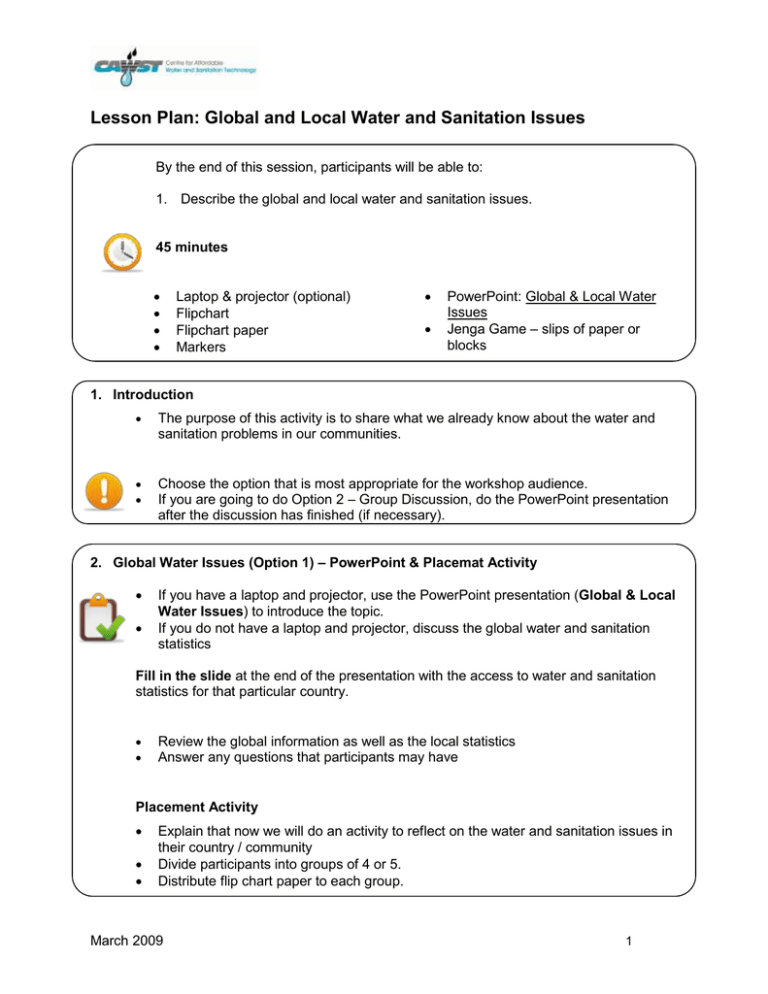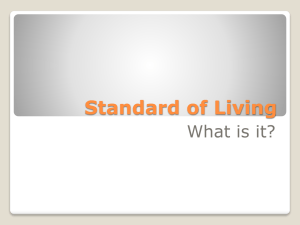Lesson Plan: Global and Local Water and Sanitation Issues
advertisement

Lesson Plan: Global and Local Water and Sanitation Issues By the end of this session, participants will be able to: 1. Describe the global and local water and sanitation issues. 45 minutes Laptop & projector (optional) Flipchart Flipchart paper Markers PowerPoint: Global & Local Water Issues Jenga Game – slips of paper or blocks 1. Introduction The purpose of this activity is to share what we already know about the water and sanitation problems in our communities. Choose the option that is most appropriate for the workshop audience. If you are going to do Option 2 – Group Discussion, do the PowerPoint presentation after the discussion has finished (if necessary). 2. Global Water Issues (Option 1) – PowerPoint & Placemat Activity If you have a laptop and projector, use the PowerPoint presentation (Global & Local Water Issues) to introduce the topic. If you do not have a laptop and projector, discuss the global water and sanitation statistics Fill in the slide at the end of the presentation with the access to water and sanitation statistics for that particular country. Review the global information as well as the local statistics Answer any questions that participants may have Placement Activity Explain that now we will do an activity to reflect on the water and sanitation issues in their country / community Divide participants into groups of 4 or 5. Distribute flip chart paper to each group. March 2009 1 Ask the participants to divide the paper into sections equal to the number of participants in the group, leaving a circle or square in the centre of the chart. Ask everyone to individually reflect on the question, issue or topic, and then silently write their thoughts in their personal area of the chart. Give a signal for the participants in each small group to discuss their thoughts. Each participant will have a turn to share with the small group. Afterwards, all small group members engage in discussion to find common elements or ideas. Ask participants to record common ideas in the centre of the place mat. Ask the small groups to post their charts and share their thoughts with the entire group. If time, allow participants to circulate around the room to look at the ideas on the charts of other groups. 3. Global and Local Water Issues (Option 2) – Group discussion & PowerPoint Print out the words found in Jenga Game. Cut out the words/phrases onto individual slips of paper or write them on Jenga blocks. Add words/phrases to the list if there is another topic you would like discuss. Jenga is a game that is played in North America with wooden blocks. If you are unfamiliar with this game, then use the slips of paper and facilitate this activity as a large group discussion. Introduce the topic and hand out the slips of paper to every participant. You can handout more than one slip of paper to each person if there are more topics than participants Invite participants to share their word/phrase with the group and explain what they know about the topic. Encourage participants to link their word/phrase with the previous word/phrase – in no particular order. If a participant does not know what their word or number means, encourage them to ask the group. Encourage discussion and questions. If you do have Jenga blocks – you can have each person take a block from the tower you’ve made to illustrate how the tower becomes unstable when all these problems are present. When each person has shared their word, summarize the discussion. The exercise is meant to illustrate how these problems are inter-connected. Clarify questions about the following: o 884 million people lack access to safe water o 2.5 billion people lack access to adequate sanitation (1.2 no toilet, 1.3 a bad toilet o MDGs – Millennium Development Goals, United Nations led initiative to promote development through reduction of poverty, achievement of universal primary education, increasing access to water/sanitation, etc. (8 goals to be achieved by 2015) March 2009 2 o o Definition of an improved water source (household connection, public standpipe, borehole, protected well, protected spring, rainwater) Definition of access to basic sanitation (connection to public sewer/septic tank, pour flush / simple pit / ventilated improved pit latrine) If you have a laptop and projector, use the PowerPoint presentation (Global & Local Water Issues) to introduce the topic. If you do not have a laptop and projector, discuss the global water and sanitation statistics Fill in the slide at the end of the presentation with the access to water and sanitation statistics for that particular country. Review the global information as well as the local statistics Answer any questions that participants may have 4. Review Summarize topics and emphasize key points. Clarify any confusion and respond to questions. 5. Reflections on Lesson Use this space to record your comments about what worked well and what didn’t, and suggestions for improvement the next time. March 2009 3


